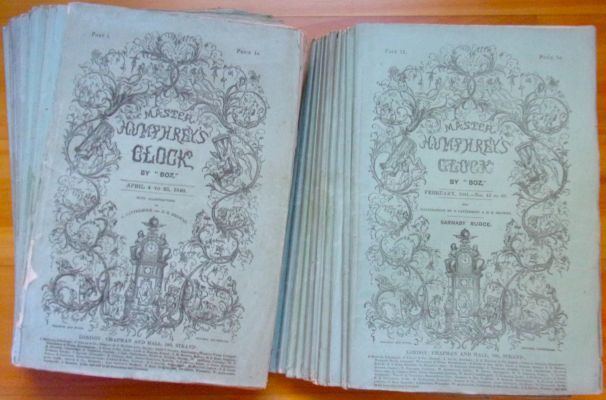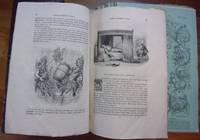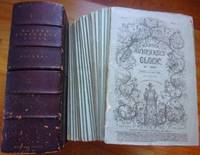MASTER HUMPHREY'S CLOCK [The Old Curiosity Shop + Barnaby Rudge, in 20 monthly parts]
- SIGNED
- 1840
1840. [in 20 monthly parts] By "Boz." With Illustrations by G[eorge]. Cattermole and H[ablot]. K. Browne. London: Chapman and Hall, 1840-1841. 20 monthly serial parts, in original pictorial light blue-green wrappers.
First Edition of THE OLD CURIOSITY SHOP and of BARNABY RUDGE, in 20 monthly serial parts. After the publication of NICHOLAS NICKLEBY in monthly parts in 1839, Dickens decided to create a weekly serial named MASTER HUMPHREY'S CLOCK, within which he would issue his future novels. The first issue, beginning THE OLD CURIOSITY SHOP, was issued on April 4, 1840. When that novel was completed 44 issues later, Dickens started right in with BARNABY RUDGE (the 45th part is a transition part). When that novel was completed in the 88th (November 27, 1841) issue, Dickens terminated the MASTER HUMPHREY'S CLOCK experiment and, beginning with MARTIN CHUZZLEWIT, reverted to his standard monthly serialization. MHC's weekly parts are quite different from Dickens's usual monthly ones: each weekly part consisted of one large sheet folded to create sixteen oversized pages (twelve of text, plus a front and rear "wrapper"), without any of the myriad inserted advertisements common to the monthly parts. In addition, the illustrations are woodcuts within the text, rather than separate steel-engraved plates. After every fourth or fifth weekly part, they were also available bound together in twenty monthly parts (as here), trimmed down a bit and with added advertisements and blue-green wrappers -- making them similar to (but larger than) Dickens's other serial parts. Following closely after these monthly parts, MASTER HUMPHREY'S CLOCK was available in three clothbound volumes, each published at intervals of about seven months -- for which the preliminary leaves are provided in monthly Parts 6, 12 and 20. Finally, simultaneous with the publication of Vol III, MASTER HUMPHREY'S CLOCK was divided and issued as two separate one-volume novels titled THE OLD CURIOSITY SHOP and BARNABY RUDGE (still paginated for three volumes in all). This set overall is in near-fine condition: about a quarter of the Part I spine is perished, but otherwise, wear is limited to occasional minor edge-wear; most parts are in close-to-fine condition (in fact the leaves of Part 5 are largely unopened). The preliminary ads for Vols I, II and III are all present as specified above. The inserted ads are all present with the exception of the Tyas ad for Part 1 (almost always lacking), plus most of one leaf of the Fisher Son & Co. ad in Part 7; the final part does contain the Virtue ads, often lacking. Gimbel A49; Hatton & Cleaver pp 161-182 (monthly parts); Smith I pp 44-57; Wolff 1804 (three volumes). Housed in a morocco-backed pull-off case (showing wear) with inner cloth chemise -- upon which chemise is the armorial "Take not this book..." bookplate of Edmund Baylies, a prominent lawyer from an old Massachusetts family.
First Edition of THE OLD CURIOSITY SHOP and of BARNABY RUDGE, in 20 monthly serial parts. After the publication of NICHOLAS NICKLEBY in monthly parts in 1839, Dickens decided to create a weekly serial named MASTER HUMPHREY'S CLOCK, within which he would issue his future novels. The first issue, beginning THE OLD CURIOSITY SHOP, was issued on April 4, 1840. When that novel was completed 44 issues later, Dickens started right in with BARNABY RUDGE (the 45th part is a transition part). When that novel was completed in the 88th (November 27, 1841) issue, Dickens terminated the MASTER HUMPHREY'S CLOCK experiment and, beginning with MARTIN CHUZZLEWIT, reverted to his standard monthly serialization. MHC's weekly parts are quite different from Dickens's usual monthly ones: each weekly part consisted of one large sheet folded to create sixteen oversized pages (twelve of text, plus a front and rear "wrapper"), without any of the myriad inserted advertisements common to the monthly parts. In addition, the illustrations are woodcuts within the text, rather than separate steel-engraved plates. After every fourth or fifth weekly part, they were also available bound together in twenty monthly parts (as here), trimmed down a bit and with added advertisements and blue-green wrappers -- making them similar to (but larger than) Dickens's other serial parts. Following closely after these monthly parts, MASTER HUMPHREY'S CLOCK was available in three clothbound volumes, each published at intervals of about seven months -- for which the preliminary leaves are provided in monthly Parts 6, 12 and 20. Finally, simultaneous with the publication of Vol III, MASTER HUMPHREY'S CLOCK was divided and issued as two separate one-volume novels titled THE OLD CURIOSITY SHOP and BARNABY RUDGE (still paginated for three volumes in all). This set overall is in near-fine condition: about a quarter of the Part I spine is perished, but otherwise, wear is limited to occasional minor edge-wear; most parts are in close-to-fine condition (in fact the leaves of Part 5 are largely unopened). The preliminary ads for Vols I, II and III are all present as specified above. The inserted ads are all present with the exception of the Tyas ad for Part 1 (almost always lacking), plus most of one leaf of the Fisher Son & Co. ad in Part 7; the final part does contain the Virtue ads, often lacking. Gimbel A49; Hatton & Cleaver pp 161-182 (monthly parts); Smith I pp 44-57; Wolff 1804 (three volumes). Housed in a morocco-backed pull-off case (showing wear) with inner cloth chemise -- upon which chemise is the armorial "Take not this book..." bookplate of Edmund Baylies, a prominent lawyer from an old Massachusetts family.




